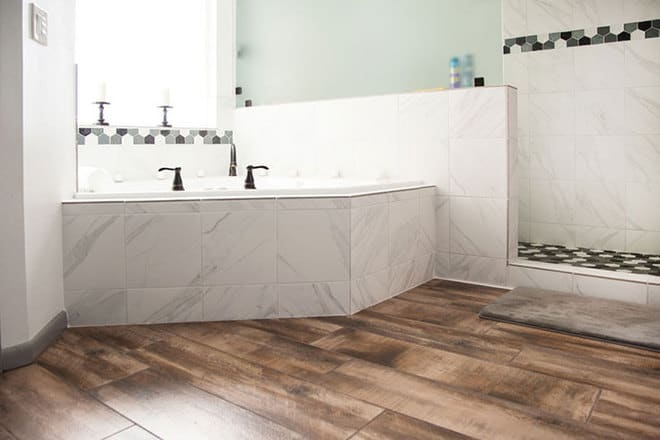
Need to know what the best type of flooring is for a bathroom? Consider ceramic, vinyl, cork and concrete, to name a few.
When it comes to choosing flooring, most homeowners focus on finding an attractive, durable material that suits their style. But there’s one major difference between bathroom flooring and the flooring of other rooms—bathroom surfaces need to be waterproof. And picking a floor that meets that need should be priority number one.
Water can splash from the sink. The toilet can overflow. Steam from the shower typically mists the entire bathroom at least once a day. A wet bathroom is not the exception but the norm, and water will wreak havoc on the wrong type of flooring. So while designing a beautiful bathroom may be your goal, keeping it waterproof should be your biggest concern. Here are some flooring options and the pros and cons of each.
Porcelain and Ceramic Tile
There’s a reason why porcelain and ceramic are classic bathroom flooring choices. Not only are they waterproof, but they’re also relatively inexpensive and can mimic the look of pricier materials such as natural stone or wood. (And while the two materials are similar in composition, porcelain is different from ceramic in that it’s made from more refined clay and fired at a higher temperature, making it more durable and less porous.)
In terms of styles, porcelain and ceramic are offered in an endless array of sizes, shapes, textures, and colors, so your design choices are practically limitless.
Porcelain and ceramic are cold to the touch, but they’re also very receptive to radiant heating laid underneath. In fact, if your desire is to have a bathroom with heated flooring, porcelain and ceramic are the most popular options.
Natural Stone
Durable and attractive natural stone always exudes an air of luxury, but it’s pricey and not completely waterproof. Softer materials like travertine and limestone need to be resealed every couple of years, while harder stones like marble and granite can last up to five years before having to reseal them. If you can afford natural stone and don’t mind refinishing the floor once in a while, it’s certainly one way to raise the resale value of your home.
Like porcelain and ceramic, stone feels cold to the touch, but this problem can be eliminated with underfloor heating. Also like ceramic and porcelain, it is a very slippery material; consider choosing a stone that’s been honed or tumbled instead of polished, or something that’s been textured with sandblasting. There are also naturally textured stones such as slate.
Vinyl
For the past decade, vinyl has surged in popularity as a bathroom flooring material due to its water-resistance, reasonable pricing, and ease of installation. This has resulted in a plethora of styles and designs flooding the market. The material comes as sheets, planks, or tiles, with sheets being the best option for bathrooms because the installation is virtually seamless, making it waterproof. There are two types of vinyl composition: wood plastic composite (WPC) and stone plastic composite (SPC). Both are made with a waterproof core, but WPC is preferred for being thicker, more flexible, and more resilient.
While vinyl is extremely durable, it can develop bumps, gaps, or curls after a period of time. Vinyl can also be hard to fix if it is pierced by a sharp object. And because the material is so well-priced, it won’t do as much for your home’s resale value as more expensive materials might.
Laminate is often confused with vinyl, but the former has a wood-chip base that makes it an inferior bathroom flooring material. If the wood comes in contact with water, it will absorb it and bubble up, and eventually the flooring will need to be replaced.
Concrete
Concrete bathroom floors are typically found in homes with slab foundations. You can also choose to have a concrete slab or overlay poured for a bathroom floor. The slab can be dyed, polished, stamped, or painted to create a sleek look that fits well with a modern aesthetic.
The advantages of concrete are that it’s completely impervious to water damage and will last a lifetime. Getting concrete stained or stamped isn’t expensive, and when you consider how long this type of flooring will last, it becomes even more cost effective.
However, concrete can be cold and hard to the touch, as well as extremely slippery if it’s finished with a smooth surface. If you’re polishing a concrete slab to use as the bathroom floor, have the finishers leave a little bit of texture for traction.
Engineered Wood
While wood and water don’t typically mix, engineered wood features a plywood base that holds up well against moisture. If you must have a wood floor in your bathroom, this is your best bet.
Engineered wood looks like real wood because the top layer is made of hardwood veneer. This is a relatively expensive option, and there’s another downside: Engineered wood is prone to damage, and you can only sand it so often before you penetrate through the veneer layer. Still, it’s a viable option that can work if you’re careful.
Solid hardwood, on the other hand, is never a good idea for bathrooms. It’s extremely sensitive to moisture and will likely eventually rot, even with a topcoat of protection.
Cork Flooring
If sustainability is important to you, consider cork as a flooring material. Waterproof and comfortable underfoot, it’s an excellent choice for the bathroom. It’s also naturally textured, which makes it the perfect non-skid surface. Plus, cork can feature some beautiful and unique grain patterns. To protect your cork flooring from moisture, reseal it every couple of years.



